The Great Savage Sword Re-Read: Vol. 2
In the first installment, I explored Volume 1 of the Savage Sword of Conan Dark Horse reprints of the classic Marvel Comics black-and-white magazine.
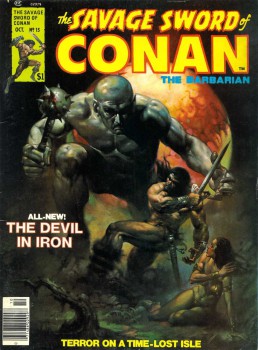 Volume 2 begins with Savage Sword of Conan #11 from 1976. A terrific issue written by Roy Thomas — who wrote most of the stories in the magazine its first few years — with art from John Buscema and Yong Montano. Buscema/Montano paring is an interesting one, and the results are every bit as lush and detailed as Alfredo Alcala’s inks in Volume One.
Volume 2 begins with Savage Sword of Conan #11 from 1976. A terrific issue written by Roy Thomas — who wrote most of the stories in the magazine its first few years — with art from John Buscema and Yong Montano. Buscema/Montano paring is an interesting one, and the results are every bit as lush and detailed as Alfredo Alcala’s inks in Volume One.
It’s too bad Montano only did this one issue of SS because he brought Buscema’s superb pencils to life as well as Alcala, yet with a decidedly different style that was no less immersive. This adaptation of Howard’s “The Abode of the Damned” isn’t your typical tale of the Cimmerian, as Conan is either off-screen or in disguise as “Shirkuh” for half the issue. It’s a brutal excursion into the violent lives of desert tribesmen, as seen through the eyes of the intrepid maiden Mellani. Seeking vengeance for her slain brother leads her right into captivity where Cimmerian-in-disguise is her only hope of surviving. Yong Montano didn’t turn into a regular Buscema inker like Alcala and later DeZuniga and Chan did, but on SS #11 he did a bang-up job creating that Buscema/Alcala level of artistic detail, while offering a fresh texture in his mastery of light and shadow.
In Savage Sword #12, reigning artistic champions John Buscema and Alfredo Alcala return to help Roy Thomas adapt Howard’s “The Slave Princess” into a Conan tale called “The Haunters of Castle Crimson.” The lush black ink work is the high standard of the magazine’s early years. Alcala’s hyper-detailed panels took Buscema’s masterful pencils to a whole new level of artistic integrity. Following their bravura performances in SS #2, 4, and 7, Buscema/Alcala bring more lighting-in-bottle greatness to these pages — and it’s their high-end work that highlights this entire second volume, beginning with SS #12.
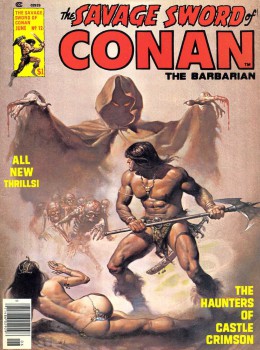 Roy Thomas both wrote and edited the magazine, so he had final say on the art teams. Roy knew he had something special in the Buscema/Alcala team, so naturally he tried to get as many issues from the team as possible. No matter that Buscema didn’t like the lush brushwork and intricate hatching of Alcala’s labors — he felt Alcala’s inks completely overpowered his pencils. It’s a pity because what really happens is a synergy that creates some of the best comics pages ever drawn and inked by hand of man. Later, Alcala changed his style with infuriating results, but when he was inking with pen and brush there was nobody who could best him on Buscema’s pencils.
Roy Thomas both wrote and edited the magazine, so he had final say on the art teams. Roy knew he had something special in the Buscema/Alcala team, so naturally he tried to get as many issues from the team as possible. No matter that Buscema didn’t like the lush brushwork and intricate hatching of Alcala’s labors — he felt Alcala’s inks completely overpowered his pencils. It’s a pity because what really happens is a synergy that creates some of the best comics pages ever drawn and inked by hand of man. Later, Alcala changed his style with infuriating results, but when he was inking with pen and brush there was nobody who could best him on Buscema’s pencils.
“I put Alfredo [Alcala] on Savage Sword mainly because he put in all that detail,” Roy Thomas told John Buscema in an Alter Ego interview. “And, coming off the Conan issues by Barry, who had put so much detail in, I thought, well, if you weren’t going to ink it yourself, we might as well noodle it up and make it look like there’s a lot of drawing there, you know?” Thomas jokingly called it “Art by the Pound” — referring to Alcala’s heavily detailed inking. The fans responded by rewarding the mag with commercial success. Buscema/Alacala was the rocket fuel taking Savage Sword to new heights.
For the first 24 issues of Savage Sword of Conan, the Buscema/Alcala team was the gold standard. However, the great Gil Kane intervened to draw SS #13, adapting “The Gods of Bal-Sagoth.” But not really: The story is a reprint from Conan the Barbarian (the color comic that began the Marvel Conan craze). The story is collected in its original color format inside The Chronicles of Conan Vol. 3. Kane’s art here is gorgeous as always, but I prefer the color version to this black-and-white tale. Unlike Alcala and Montano, Kane’s inkers (Ralph Reese and Dan Adkins) inked these pages for a color publication — and you can really sense the missing color.
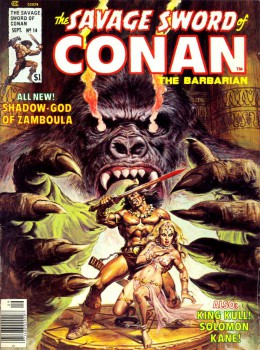 Issue #14 of Savage Sword is a tour de force and a bonafide classic. Thomas adapts Howard’s “Shadows in Zamboula” (originally titled “The Man-Eaters of Zamboula”) and living legend Neal Adams steps in to pencil one of the most unforgettable issues ever to see print. Inks are credited only to “The Tribe” — which means any number of inkers that were assisting Adams at the time. Tony DeZuniga was a notable member of this tribe — his work inking Adams here is both prevalent and exquisite. DeZuniga would go on to become another “perfect” artistic partner with John Buscema. Tony DeZuniga’s inks on Savage Sword are widely considered to have been rivaled in quality mainly by the inking of Alfredo Alcala and Ernie Chan. Together they form a triumvirate of “ultimate Buscema” artwork that forms the core of Savage Sword‘s first ten years.
Issue #14 of Savage Sword is a tour de force and a bonafide classic. Thomas adapts Howard’s “Shadows in Zamboula” (originally titled “The Man-Eaters of Zamboula”) and living legend Neal Adams steps in to pencil one of the most unforgettable issues ever to see print. Inks are credited only to “The Tribe” — which means any number of inkers that were assisting Adams at the time. Tony DeZuniga was a notable member of this tribe — his work inking Adams here is both prevalent and exquisite. DeZuniga would go on to become another “perfect” artistic partner with John Buscema. Tony DeZuniga’s inks on Savage Sword are widely considered to have been rivaled in quality mainly by the inking of Alfredo Alcala and Ernie Chan. Together they form a triumvirate of “ultimate Buscema” artwork that forms the core of Savage Sword‘s first ten years.
The super-team of Buscema/Alcala returns for “The Devil In Iron” in SS#15, and rides directly into a multi-part “People of the Black Circle” adaptation for issues #16 – #19. Here’s where the cracks in the Buscema/Alcala partnership begin to show. Alfredo’s highly-detailed inking — bringing the Hyborian Age to life in three-dimensional depth with line, brush, and black ink–had to be extremely time-consuming. So the incredible ride that began with “People of the Black Circle” inevitably stalls out in issue #18.
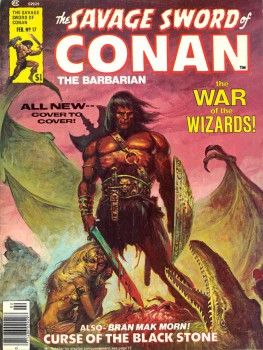 After crafting three eye-popping, superbly-rendered issues in a row (#15, 16, 17) Alcala must have needed a break. It was the third part of a four-part story, and I can’t think of anything else that explains what happens to the Buscema/Alcala partnership in #18. Alcala must have realized he couldn’t ink all of that issue in time for the deadline, so his eyes must have strayed across the room to his drawing board..and the sticks of charcoal lying there. Thus begins his first experiment using charcoal over Buscema’s pencils instead of painstaking, time-consuming inks with brush and pen. The results are, frankly, a huge let-down. SS #18 is such a vast departure in style — and basic quality — that it can hardly be considered a success as part of a quadrology, let-alone a single issue.
After crafting three eye-popping, superbly-rendered issues in a row (#15, 16, 17) Alcala must have needed a break. It was the third part of a four-part story, and I can’t think of anything else that explains what happens to the Buscema/Alcala partnership in #18. Alcala must have realized he couldn’t ink all of that issue in time for the deadline, so his eyes must have strayed across the room to his drawing board..and the sticks of charcoal lying there. Thus begins his first experiment using charcoal over Buscema’s pencils instead of painstaking, time-consuming inks with brush and pen. The results are, frankly, a huge let-down. SS #18 is such a vast departure in style — and basic quality — that it can hardly be considered a success as part of a quadrology, let-alone a single issue.
The interesting thing here is the superhuman art-strength of Big John Buscema. No matter the deadlines, his pencils never lost a bit of punch. They’re not the problem with Savage Sword #18 — the problem is wholly Alfredo Alcala’s decision to use a charcoal technique on the issue — and Roy Thomas’ decision to go along with it.
I know — I know — the Dreaded Deadline Doom was all too common at Marvel in the 70s. Roy had a lot of fish to fry in addition to writing/editing this mag. He probably figured “Better to put out a shabby-looking issue than no issue — and maybe people will even like the charcoal style…” Whatever the rationale, this part three of the “People of the Black Circle” completely ruins the adaptation — it doesn’t fit AT ALL with the look of the art of the first three issues that came before it — or the issues that comes RIGHT AFTER IT.
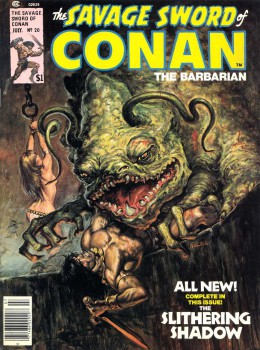 Yes, Alcala must have known his work wasn’t up to par–the charcoal strategy must have been an emergency strategy only–because in the very next issue, SS #19, he delivers all the lushness of line and shadow that fans had come to expect from earlier issues. Part 4 of the “Black Circle” adaptation is as great as part 3 was lame. It’s a return to the Buscema/Alcala gold standard: The charcoal is a distant memory, and the pens and brushes of Alcala are dripping ink black as gore once again. Times were good.
Yes, Alcala must have known his work wasn’t up to par–the charcoal strategy must have been an emergency strategy only–because in the very next issue, SS #19, he delivers all the lushness of line and shadow that fans had come to expect from earlier issues. Part 4 of the “Black Circle” adaptation is as great as part 3 was lame. It’s a return to the Buscema/Alcala gold standard: The charcoal is a distant memory, and the pens and brushes of Alcala are dripping ink black as gore once again. Times were good.
The glorious rebound of the Buscema/Alcala team flowed right into Savage Sword #20, when they tackled Thomas’ adaptation of “The Slithering Shadow,” one of Howard’s “lost-city” tales–and one of his least acclaimed Conan tales. Despite its humble origins–and its similarity to various other Howard tales, recycled plot elements, etc. — the issue looks amazing and reads like another perfect Buscema/Alcala thriller. The intensity of the artwork elevates the source material to a superb experience of sword-and-sorcery the likes of which Savage Sword fans hoped to see every issue.
In issue #21 Sonny Trinidad comes along to give hard-working Alcala a break. The results are serviceable, but nothing to write home about. The issue is dogged by a persistent “filler” atmosphere–except for a few pages when it truly looks like Buscema was inking himself. Perhaps he was — everybody needed help on deadlines now and then — producing comic books was and still is a team effort. Dark Horse mis-credits Sonny Trinidad as Alfredo Alcala on their reprint issue of #22, “Pool of the Black One.” One look at this tale and I could tell it wasn’t Alcala inks as listed — a quick web search later and I confirmed that issue #22 was also a Trinidad issue. Again, a functional job by Trinidad, but markedly different from the Buscema/Alcala “look” that had come to dominate the mag.
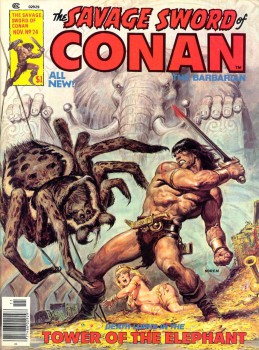 Savage Sword #23 is credited to Buscema and Alcala. It’s part two of “The Pool of the Black One” but here we are switching inkers from Trinidad to Alcala. It’s a bit jarring, but it’s great to have the Alcala “house style” back. The book is kicking again, but wait: Is that really Alcala inking? Yes, it is… but he’s holding back. He’s leaving space in the panels, man! He’s not rendering in that luscious detail the way he has been.
Savage Sword #23 is credited to Buscema and Alcala. It’s part two of “The Pool of the Black One” but here we are switching inkers from Trinidad to Alcala. It’s a bit jarring, but it’s great to have the Alcala “house style” back. The book is kicking again, but wait: Is that really Alcala inking? Yes, it is… but he’s holding back. He’s leaving space in the panels, man! He’s not rendering in that luscious detail the way he has been.
Is it the deadline problem again or have Buscema’s complaints gotten back to him? Is he reacting to criticism, simply trying to meet deadlines, or both? The issues reads like “Alcala light” — it’s Alcala doing his inking with brush and pen — but also throwing in some grayscale wash techniques now and then: patterns of grey that used to be composed of hundreds of minuscule lines. The man’s hatching techniques were 9th degree wuxia, after all. I’ll bet 70s readers were wondering “What’s up with Alcala?” That’s two bad issues — the deeply flawed charcoal-inks and the “Alcala-light” job in SS#23. But not to worry…
Savage Sword #24 brings the thunder. Thomas re-adapts one of Howard’s all-time best Conan stories “The Tower of the Elephant.” If there were any rumblings about Alacla’s “losing it” he promptly squashed them. This adaptation is one of Conan’s great moments, and it is pure Buscema/Alcala genius. An issue that rivals all other issues. Six years earlier Thomas and Barry Windsor-Smith had adapted “Elephant” as the first-ever Marvel Conan tale taken directly from a Howard prose story.
Now that he had done so many other great adaptations of Howard’s work, Roy got to take a second shot at “Tower of the Elephant.” This time he chose the Buscema/Alcala team because it was the state-of-the-art in sword-and-sorcery artistic brilliance. 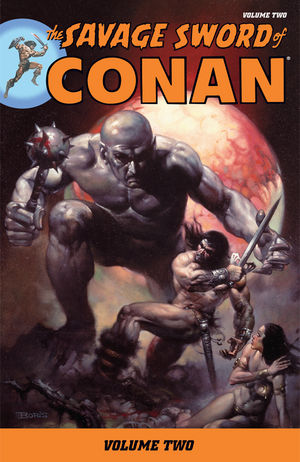 Nowhere is that brilliance more evident in this single issue.
Nowhere is that brilliance more evident in this single issue.
Comparing the Thomas/Windsor-Smith “Elephant” adaptation from Conan the Barbarian #4 with the Thomas/Buscema/Alcala “Elephant” adaptation from SAVAGE SWORD #24 is a perfect way to show how different both Conan publications truly were. This latter adaptation seems less rushed and more evocative of the original text — it’s a more mature approach for a more mature publication. It’s pure Buscema/Alcala magic.
It’s also a pitch-perfect ending for Savage Sword of Conan Vol. 2.
Praise Crom.
NEXT TIME: A look into Volume 3, where history intersects my own lifeline and I get to re-read my first-ever copy of Savage Sword — issue #28, “Blood of the Gods” by you-guessed-it: Thomas, Buscema, and Alcala. LEGEND. Read it here.
John R. Fultz is the author of several novels including THE TESTAMENT OF TALL EAGLE and the Shaper Trilogy: SEVEN PRINCES, SEVEN KINGS, and SEVEN SORCERERS. His website is www.johnrfultz.com
[…] Second entry in a series running now at BlackGate.com […]
I am loving these articles. SSOC # 186 – The Horror out of Time was the first one I encountered. Needless to say I immediately put in a call order at my local newsagent for future issues. Sadly SSOC didn’t last too much longer, being repositioned as Conan the Savage and then disappearing.
Until # 187 the only Conan I had read was Hour of the Dragon, but I was hooked and have since then picked up a respectable collection of back issues.
Now for the big question. I actually have SSOC issue #1, but it’s the Marvel UK edition. I am not too fussed about that bar I am concerned the content isn’t the same. I seem to recall it being a few shorts, including The Thing in the Crypt?
Looking forward to when you encounter the Bran mac Morn – Worms of the Earth story in SSOC. Awesome, but the Star Comics re mastered and coloured edition is a must have.
This is the one volume of the reprints that I have so far. I didn’t grow up with these, so they are new to me, but yes the art is fantastic. I’ve recently been persuaded to try out D&D 5th edition because of the reviews here and now after having spent more time with the books, I’ll relent somewhat on my complaints of the artwork. It’s not as bad as I originally thought, but it’s still not as good as old TSR-era D&D art and certainly not as good as the pen and pencil art in SS. Detail is a big part of it, with the new D&D art seemingly preferring a more blurry (and colorful)aesthetic.
BTW, John, I loved your story “Chivaine” in Weirdbook #31. I also read your article in Grimdark #4 about Grimdark fantasy being today’s Sword & Sorcery, but I didn’t quite buy the argument, since a number of Grimdark fantasy tales seem to be more epic in nature. But an intriguing read, nonetheless.
This collection has a bunch of my favorite stories – actually Shadows in Zamboula is my first REH Conan story which I read after liking Savage Sword – I found the comics version years later. That story was really good.
Dark Horse’s run has been pretty good, but they wussed out in “People of the Black Circle” and I worry they’ll skip or ignore Shadows.
Also, I don’t know if he read the comic when it came out or the Lancer re-prints of the story, (late 60s, early 70s seems the time) but it inspired an angry young black man – Charles Saunders – got him steamed up full of “Ire and Brimstone” to write his own heroic fantasy -the Imaro series- but as a turnaround to the cliches on his own background/race.